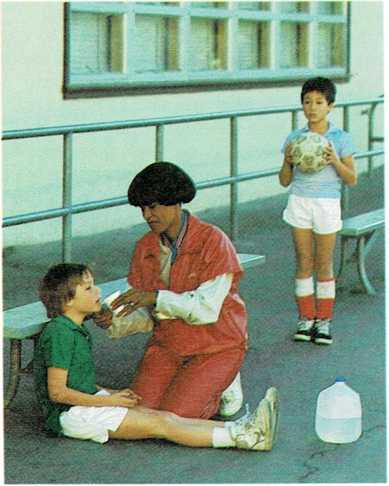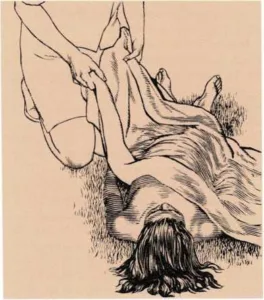Heat Exhaustion – Hepatitis
Heat exhaustion is one of the body’s reactions to overheating and
inadequate fluid intake. It usually occurs during strenuous exercise
when sweating makes the body lose too much water. Heat exhaustion is not
the same as heatstroke. A child with heat exhaustion continues to sweat;
a child with heatstroke usually does not.
The symptomatic onset of heat exhaustion is often gradual. A child may
become pale and weak. Body temperature remains normal. The child may
complain of headache, dizziness, weakness, and cramps, may become
nauseated and vomit, and may seem disoriented. Skin feels moist and
clammy, and the pulse may be weak and irregular. Move the child to a
cooler place. Cover the child with ice-water-cooled towels and offer
drinking water. Call the doctor.
To prevent heat exhaustion, dress your child in lightweight,
loose-fitting clothing that is light in color. Keep strenuous play to a
minimum during extreme heat, and see that the child drinks a lot of cool
fluids before and during periods of activity, [m.g]
See also Heatstroke
Heatstroke (sunstroke) results when the body’s heat-regulating
system stops functioning normally. Heatstroke is caused by excessive
heat, not by the sun itself.
One way the body normally cools itself is by sweating. A child with
heatstroke usually

If a child is suffering from heat exhaustion, first move the
youngster to a cooler place and offer cool water. Call a doctor as
soon as possible.
First aid for heatstroke

If you cannot put the child into a tub of cold water, put wet cloths
directly against the child\’s skin. If possible, put ice packs against
the back of the child’s neck.
stops sweating. This is not, however, always the case. The child’s skin
may become flushed, hot, and dry; and the child may become agitated,
confused, lethargic, or convulsive, or lose consciousness. When the
child stops sweating, the body temperature rises. The temperature is
usually over 105° F. (41° C); at this level, it is necessary to lower
the child’s temperature immediately.
Place the child in a bathtub of ice-cold water until the temperature
goes down to 102° F. (39° C) or lower. If this is not practical, take
off the child’s clothing and put wet cloths and ice bags directly
against the skin. Call a doctor and arrange for transportation to an
emergency medical facility at once. Infants, especially, are at great
risk of heat- related illnesses; never leave an infant in a closed
automobile on a warm day. Heatstroke can be fatal, [m.g.]
See also Heat exhaustion
Hemoglobin. See Anemia; Blood count
Hemophilia is a hereditary disease in which the blood does not clot
properly and bleeding is difficult to stop. Hemophilia occurs almost
entirely in males. Women rarely show signs of the disease, but they
carry it and transmit it to their sons.
Hemophilia varies from severe forms in which bleeding occurs after
almost any activity, to milder forms in which only major injuries or
surgery produce excessive bleeding. The bleeding may occur internally as
well as from a cut on the skin. Internal bleeding usually occurs in body
tissues, in muscles, or in joints such as those at the knee, ankle,
elbow, or hip.
No cure has yet been found for hemophilia, but bleeding can be
controlled with normal blood plasma or with concentrates of clotting
factors (medicines that help clot the blood). Prompt medical treatment
can prevent large hemorrhages that might permanently damage joints,
tissues, or organs. Surgery and dental extractions can be performed
without danger of hemorrhage if the child with hemophilia is first
treated with plasma or the concentrates of the clotting factors.
Hemophilia is sometimes apparent in newborn infants. They bleed
excessively from the umbilical cord or following circumcision. More
commonly, the disease becomes evident when the child begins to crawl or
walk. Small bumps cause large braises and swelling, which are signs of
large areas of hemorrhage. If this happens, have the child examined
immediately by your doctor. If you know there is a history of hemophilia
in your family, report this to the doctor who will deliver the baby and
to the baby’s pediatrician. The baby’s doctor will probably want to
examine the child at about 3 months.
Once hemophilia is diagnosed, doctors usually recommend protecting the
child from activities that might produce injury—for example,
discouraging tree climbing or physical contact sports such as football,
[f.o.]
See also Blood clotting; Bruises; Heredity
Hemorrhage. See Bleeding; Hemophilia
Hepatitis is a disease that involves inflammation of the liver. The
two major types of hepatitis are viral and toxic.
There are two main forms of the viral type: hepatitis A, or infectious
hepatitis, and hepatitis B, or serum hepatitis. Symptoms of both include
headache and loss of appetite and energy. A child may also be nauseated,
vomit, and have abdominal pain. Urine may look greenish-yellow and
stools may be pale. Older children may have a temperature of 100° to
104° F. (38° to 40° C) for two to five days. As the fever subsides,
jaundice (a yellowing of the skin and whites of the eyes) usually
appears. Normally, jaundice lasts from 8 to 11 days.
Most cases of hepatitis A, or infectious hepatitis, are caused by
contaminated food or water. Symptoms appear in about four weeks. Most
cases of hepatitis A last about two to six weeks.
Symptoms may be lessened—or even prevented—if injections of gamma
globulin are given within a week after exposure. A child should be
isolated for at least one week after the onset of the disease.
Take every possible care to protect others in the family. Be certain
that everyone
washes his or her hands before meals and after bowel movements.
Provide separate eating utensils for the sick child and sterilize them
after use. One attack of infectious hepatitis usually gives permanent
immunity.
Hepatitis B, or serum hepatitis, is less common than hepatitis A, or
infectious hepatitis. Once commonly transmitted through a transfusion of
blood, hepatitis B is now mainly spread by use of improperly sterilized
medical instruments.
Symptoms appear in from 60 to 180 days, with an average of about 90
days. Children with hepatitis B do not have to be isolated. Hepatitis B
immunoglobulin is recommended for those patients exposed to hepatitis B.
The hepatitis B vaccine may also be administered. Those at risk for
hepatitis B exposure should be immunized.
Toxic hepatitis results from exposure to certain chemicals, including
carbon tetrachloride and a variety of medications. Such chemicals can
enter the body by being swallowed, inhaled, absorbed through the skin,
or received in injections. Treatment depends upon the cause.
See also Gamma globulin; Jaundice

